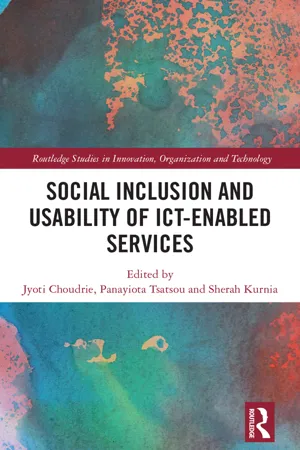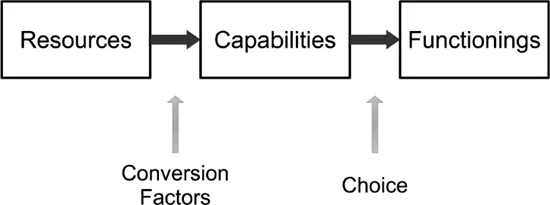![]()
Part I
Examining the Theoretical Foundations of Social Inclusion and ICT-Enabled Services
![]()
1 Social Inclusion and ICTs
A Literature Review Through the Lens of the Capability Approach
Efpraxia D. Zamani
1. Introduction
Social inclusion is considered to lead to equal participation in society, and to people’s welfare (Gingrich and Lightman 2015). Policy makers have put forth the adoption of ICTs, arguing that these can deliver reforms and support disadvantaged individuals to overcome long-standing inequalities (Sourbati 2012). However, mere adoption of ICTs is not enough to achieve social inclusion. Rather, it is necessary that the design and the functionality of ICTs meet the needs and expectations of disadvantaged individuals (Zheng 2009), as these can help them meet their personal goals.
Disadvantaged individuals exhibit quite different characteristics, which form their needs and expectations. ICTs that may support one type of individuals and help them overcome some impediments may inhibit others’ access. At the same time, desirability is important for the successful use of ICTs. Therefore, ICTs need to account both for what individuals are able and wish to achieve.
This chapter investigates the abilities, needs, and desires of individuals who experience social exclusion by focusing on the role of ICTs. It is based on a literature review of previous studies at the crossroad of social inclusion and ICTs. Drawing upon Sen’s Capability Approach (Sen 2000), it identifies the individual abilities, the opportunities and the expectations a disadvantaged person has so that s/he can lead a life s/he values (Zheng 2009). In this sense, it illustrates the needs and requirements of disadvantaged individuals, with the aim to facilitate the discussion on social inclusion through ICTs.
2. Background
2.1 Social Inclusion and ICTs
Social inclusion is much more than challenging financial inequalities (Notley 2009). It entails that individuals participate equally in structures, activities, and their communities, because they are able and permitted to partake in society (Guildford 2000). Along these lines, the availability of ICTs is a necessary condition for one to be able to conduct a certain type of life in today’s interconnected society (e.g., Jaeger and Xie 2009). Specifically, there is a linkage between ICTs and social development (Helsper 2008), and ICTs can help in bridging social inequalities, while, alongside other things, they may support development and lead to improved education, government, and health care (e.g., Zheng 2009). In addition, ICTs can strengthen existing social ties and support the development of new ones, because mobile phones, online social networks and the likes enable two-way communication (Zinnbauer 2007). Equally so, ICTs may lead to social exclusion when there is a lack of basic ICTs skills, infrastructures (Zheng and Walsham 2008) or due to increased costs (Khorshed and Imran 2015). It is thus important, on the one hand, to ensure the necessary conditions, the financial resources and often the political support for the deployment of technical infrastructures and other practical arrangements (Fernback 2005). On the other hand, governmental and private initiatives need to safeguard that ICTs allow and support the inclusion of individuals in everyday activities (Eisma et al. 2004).
2.2 Capabilities and Deprivation
The Capability Approach builds upon two concepts: functionings and capabilities. Capabilities relate to the notion of freedom and “what real opportunities you have regarding the life you may lead” (Sen 1987: 36). Functionings refer to the well-being of a person, and to associated achievements and expectations (Sen 1987; Zheng 2009). Functionings and capabilities are related to each other in the sense that capabilities describe one’s freedom to achieve a set of potential functionings—i.e., the possibility to achieve something. Based on one’s choice, the individual will then achieve one functioning from the many potential ones.
Another aspect of the Capability Approach is human diversity (Zheng and Walsham 2008), which is introduced into the theoretical framework in the form of conversion factors, and can be personal, social and environmental (Robeyns 2005). The resources one has at their disposal, such as the Internet or food, contribute toward them achieving a set of functionings. For example, a smartphone can contribute toward one’s participation in their community by allowing for communication channels with the local authority and friends. Based on one’s conversion factors, we understand whether and to what extent they can convert the available resources into desired functionings. An individual with basic ICT skills can take advantage of the smartphone’s features, whereas someone with no ICT skills will not be able to operate the device. Therefore, personal conversion factors are internal—i.e., physical condition, literacy, and ICTs skills, etc. Social conversion factors relate to social norms, policies, and power structures among others. Environmental conversion factors then relate to the geographical location, features of the natural, and human made environment, such as infrastructures (Robeyns 2005; Zheng and Walsham 2008).
Figure 1.1 An Illustration of the Capability Approach (Adapted from Verd and Lopez Andreu (2011)).
Figure 1.1 presents the relationship between resources, conversion factors, capabilities, and functionings.
As a result, individual differences, the opportunities, and the variations across societies need to be taken together, toward pinpointing the needs of individuals who are considered to be at risk or already affected by social exclusion. In this light, ICTs can strengthen one’s capabilities by bringing down the barriers that prohibit people from further cultivating them. Yet, in order to convert capabilities into functionings, there need to exist strategies and policies that mediate the use of ICTs (Alhareth, Alhareth, and Dighrir 2015).
Examining individuals at the verge of social exclusion through the Lens of the Capability Approach can be useful specifically because of the theory’s central tenet; it is very clear that its objective is to provide deprived individuals with the freedom to enjoy what they themselves consider valuable.
Following the method section, this chapter identifies groups at the risk of social exclusion, or those who are already deprived of their capabilities, based on a literature review of earlier works and pinpoints their particular requirements. The use of secondary rather than primary material has been chosen because social inclusion has received significant attention, and therefore there is already ample empirical material regarding the requirements of various groups; however, despite the availability of abundant information, this is rather fragmented, and most often, a single study focuses exclusively on one single group of individuals (e.g., older adults). Therefore, this chapter examines collectively the requirements of several groups so as to investigate possible similarities and differences, and facilitate the comparison of common themes across them. As a result, it is posited that it can enhance the practical use of previous findings by policy makers and help in forming policy actions that can boost social inclusion.
3. Method
A primary literature review was undertaken in order to identify relevant studies. This was done through Google Scholar, because it includes gray literature and citation metrics that help in quickly appreciating the article’s impact. The keywords used were “social inclusion,” “social exclusion,” and “ICT.” This set of keywords isn’t very restrictive, and therefore relevant literature was also identified through Scopus and snowballing through citation tracking, so as to refine the pool of articles. Publication time was the second criterion; the search covered the 2000–2015 period, which allowed the saturation of the findings. Studies being more focused on the digital divide and less on social inclusion were excluded.
Finally, much of the social inclusion literature deals with the use of ICTs by individuals with disabilities. According to the World Health Organization, disability “is an umbrella term, covering impairments, activity limitations, and participation restrictions”1 and can thus be physical, sensory, intellectual, mental, developmental, or a combination of these. Therefore, social inclusion of the hard of hearing would entail, for instance, actions for increased accessibility (Harris and Bamford 2001), whereas the case of mental health disabilities would suggest actions to reduce stigma, support recovery, ensure anonymity, etc. (Stephens-Reicher et al. 2011). In other words, each disability entails different resources and conversion factors, and leads to different functionings and examining the needs of disabled individuals collectively as a single group would inadvertently lead to reducing the importance of each subgroup’s individual differences. For this reason, studies examining ICT-facilitated social inclusion of disabled individuals in general have also been excluded.
The final pool consisted of 46 research papers. The analysis entailed first their classification according to the examined group, and the collated findings led to the identification of six main groups. Next, the analysis continued by examining the studies along the main concepts of the Capability Approach—namely, resources, conversion factors, capabilities, and functionings.
4. Identifying Groups at the Verge of Social Exclusion
This section discusses the needs and requirements of the six identified groups and examines their capabilities that are essential to take advantage of the opportunities offered by ICTs. It is that this chapter investigates the achievable functionings without examining the purposeful rejection of or the lack of interest in ICTs (Haddon 2000).
4.1 Older Adults
Being elderly suggests that, most likely, the individual is to some extent already isolated with a constrained social network, which “reduces the likelihood of benefiting from social applications of the Internet” (Helsper 2008: 12). At the same time, user interfaces and interaction modalities (e.g., keyboard) used by laptops, tablets, and the like, tend to be confusing for the elderly. This reduces older adults’ accessibility to services such as online social networks, the Internet and text messaging among others (Teixeira et al. 2012), and adds additional constraints to their communications. However, communication technologies are integral for the elderly’s successful inclusion in their communities.
Older adults tend to experience difficulties in relation to their motor skills (Teixeira et al. 2012), they are less mobile, experience health problems, cognitive impairment, or may be affected by more than one of the aforementioned issues. As a result, not all technologies will allow their equal access to ICTs (Jaeger 2006). Their characteristics may work against them and cause their deprivation of their capabilities, and prohibit them from pursuing the life they would like to lead.
At the same time, it is these personal characteristics that will act as the conversion factors based on which older adults will convert their capabilities into the functionings they choose. Older individuals today grow old under much different conditions compared to the past; they retire later and continue working part-time after retirement, they desire to remain independent and active, and generally do not consider themselves “old” (Roberts 2010). This entails that they want and need to remain stimulated. In addition, while they tend to live alone, they need to live embedded in a caring support network, so that they can have a good quality of life as they age. Through this network, they have the opportunity to be in touch through a two-way communication with their carers, who can be family members or professionals, and send/receive information, keep updated with important information and so forth (Waterworth et al. 2009).
As a result, it is necessary that ICTs support them in overcoming whatever difficulties arise due to aging. Older adults seek to have adequate and easy-to-use communication channels and quite often turn to ICTs in order to satisfy this need (Choudrie, Grey, and Tsitsianis 2010). Conversely, the products and services they use need to be appealing, easy to use and accommodating of their situation (Pirkl 2009), so that they can live independently, age successfully, and remain active members of today’s society.
4.2 Single Parents
Quite often, single parents find themselves at risk of social isolation when they create their own household, and experience increased levels of loneliness (Haddon 2000). Previous studies (e.g., Hardey 1989) have underlined that female-headed single parent households in particular are faced with an increased risk to be near poverty levels, quite often because of a diminished income due to divorce or separation (Russo Lemor 2005). Therefore, for this type of individuals, Internet access, and even more traditional forms of ICTs like the telephone, can be of particular importance. On the one hand, ICTs can help them in...

